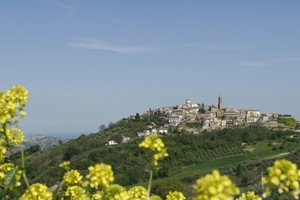Cellino Attanasio
| Informazioni |
|---|
| Mappa e contatti |
The legend has it that the name of this village comes from “Cillenius”, an epithet given to the God Mercury, to whom a temple built on top of Colle S.Marco would have been dedicated.
The mediaeval borough lays on top of a hill that has long been dominated by the neighbouring town of Hatria. The powerful Lords of Acquaviva chose this particular site to settle their refuge using the numerous exciting fortifications. Unfortunately only few ruins remain today of the great town walls once bearing nine donjons.
Among the sites worth visiting are the Parish Church of S. Maria la Nova with its 1424 portal, executed by the Neapolitan artist Matteo de Caprio and its peculiar bell tower built with terracotta at the top and stones at the bottom. In its inside are kept a sumptuous baroque wooden altar with a 15th-century tabernacle and a column with capital for the Paschal candle dating back to 1383. Noteworthy is the 15th-century funeral monument dedicated to the young Duke Giovan Battista d'Acquaviva inspired by Tuscan Renaissance style.
The "Cingoli cellinesi al sugo di papera", a traditional type of pasta in duck sauce, also named “monk girdles”, are a product of history and folklore. This characteristic meal dates back to the Middle Ages and is linked to the presence of Franciscan monks, for whom the cingoli represented the typical “meal for feast days” .
Passing through the ancient convent, a monk had once prescribed that a fast was to be observed on the 10th of January to ward off the danger that the village would sink into a lake of fire, which according to him lied right under it (obviously the burning lake did not exist but the fact that Cellino actually spreads over a rich deposit of methane is certainly noteworthy). According to this custom the end of the fast day would than be celebrated by eating this dish made of big macaronis similar to the girdles, called “cingoli”, which the monks used to wear as a belt.

















